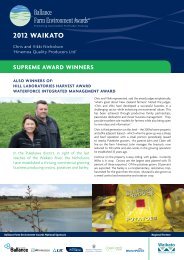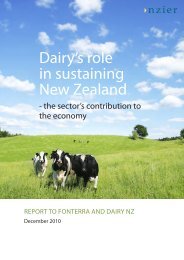Hearing Evidence – Brunner - Federated Farmers
Hearing Evidence – Brunner - Federated Farmers
Hearing Evidence – Brunner - Federated Farmers
Create successful ePaper yourself
Turn your PDF publications into a flip-book with our unique Google optimized e-Paper software.
Department of Conservation Change fencing distance from the waterway<br />
from 1 metre to 3 metres.<br />
Decision Requested: 18.1.56<br />
10<br />
Implement Policy 9.3.5 region-wide -<br />
Decision Requested: 9.29<br />
41. We see the relief sought by the above submitters as unnecessary and unreasonable in<br />
consideration of the overall broad judgement of likely environmental benefits against<br />
economic and social cost to farmers and the wider community. We therefore support<br />
the recommendations in the 42A report to reject these submissions.<br />
42. In regard to requests to extend the 1 metre buffer within the Lake <strong>Brunner</strong> catchment<br />
up to 10 metres, or to extend stock access provisions for Lake <strong>Brunner</strong> to the<br />
remainder of the region, we note that:<br />
Very substantial areas of land will be lost to production, for little environmental<br />
improvement in terms of the actual state or health of the receiving water body.<br />
Due to the potential loss of land and social and economic effects that might arise<br />
if the Council were to accept further submissions, we question the<br />
recommendation in the 42A report at Decision Requested: 9.30 to reject our<br />
submission on possible costs of Policy 9.3.5;<br />
outside the <strong>Brunner</strong> catchment, water quality is good or getting better in all<br />
surface water bodies, which suggests that increased regulatory intervention is not<br />
necessary;<br />
compared to other parts of New Zealand, West Coast farms are relatively smaller<br />
and with lower stocking rates;<br />
stock exclusion can be very difficult to achieve on dry stock properties where a<br />
permanent 7 wire fence is required to stop stock, land may be steep with<br />
numerous intersecting streams and ephemeral watercourses, and where farmers<br />
often rely on natural flowing water for stockwater. Dry stock properties are also<br />
generally farmed less intensively than dairy farms, with lower densities of animals<br />
that can impact on creeks;<br />
pest plants are a major problem on ungrazed land on the West Coast, and this<br />
will be no different in riparian areas. Controlling these, or managing an effective<br />
transition to native vegetation often results in much higher costs than building a<br />
permanent fence in the first place;<br />
stock exclusion can result in lack of access to maintain creek beds, which will<br />
result in enhanced flood risks.
















